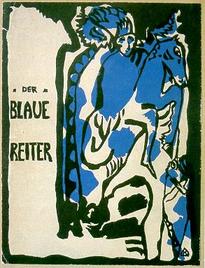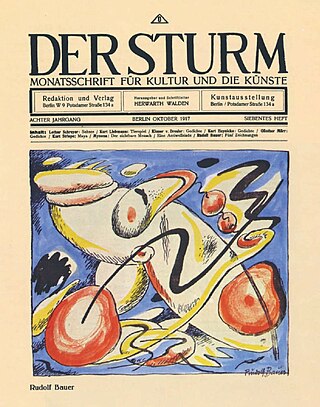
Wassily Wassilyevich Kandinsky was a Russian painter and art theorist. Kandinsky is generally credited as one of the pioneers of abstraction in western art. Born in Moscow, he spent his childhood in Odessa, where he graduated from Odessa Art School. He enrolled at the University of Moscow, studying law and economics. Successful in his profession, he was offered a professorship at the University of Dorpat. Kandinsky began painting studies at the age of 30.

Modern art includes artistic work produced during the period extending roughly from the 1860s to the 1970s, and denotes the styles and philosophies of the art produced during that era. The term is usually associated with art in which the traditions of the past have been thrown aside in a spirit of experimentation. Modern artists experimented with new ways of seeing and with fresh ideas about the nature of materials and functions of art. A tendency away from the narrative, which was characteristic of the traditional arts, toward abstraction is characteristic of much modern art. More recent artistic production is often called contemporary art or Postmodern art.

Der Blaue Reiter was a group of artists and a designation by Wassily Kandinsky and Franz Marc for their exhibition and publication activities, in which both artists acted as sole editors in the almanac of the same name. The editorial team organized two exhibitions in Munich in 1911 and 1912 to demonstrate their art-theoretical ideas based on the works of art exhibited. Traveling exhibitions in German and other European cities followed. The Blue Rider disbanded at the start of World War I in 1914.

The Staatsgalerie Stuttgart is an art museum in Stuttgart, Germany, it opened in 1843. In 1984, the opening of the Neue Staatsgalerie designed by James Stirling transformed the once provincial gallery into one of Europe's leading museums.

The Pinakothek der Moderne is a modern art museum, situated in central Munich's Kunstareal.

Karl Christian Ludwig Hofer or Carl Hofer was a German expressionist painter. He was director of the Berlin Academy of Fine Arts.

Der Sturm was a German avant-garde art and literary magazine founded by Herwarth Walden, covering Expressionism, Cubism, Dada and Surrealism, among other artistic movements. It was published between 1910 and 1932.

Adolf Richard Hölzel was a German painter. He began as a Realist, but later became an early promoter of various Modern styles, including Abstractionism.

The Museum Ostwall is a museum of modern and contemporary art in Dortmund, Germany. It was founded in the late 1940s, and has been located in the Dortmund U-Tower since 2010. The collection includes paintings, sculptures, objects and photographs from the 20th century, plus over 2,500 graphics, spanning Expressionism through classic modern art to the present day.
Triadisches Ballett is a ballet developed by Oskar Schlemmer. The ballet became the most widely performed avant-garde artistic dance and while Schlemmer was at the Bauhaus from 1921 to 1929, the ballet toured, helping to spread the ethos of the Bauhaus.

Willi Baumeister was a German painter, scenic designer, art professor, and typographer. His work was part of the art competitions at the 1928 Summer Olympics and the 1932 Summer Olympics.

Otto Meyer-Amden was a Swiss painter and graphic artist.
Pedagogical Sketchbook is a book by Paul Klee. It is based on his extensive lectures on visual form at Bauhaus Staatliche Art School where he was a teacher in between 1921-1931. Originally handwritten – as a pile of working notes he used in his lectures – it was eventually edited by Walter Gropius, designed by László Moholy-Nagy and published in as a Bauhaus student manual under the original title: Pädagogisches Skizzenbuch. It was translated into English by Sibyl Moholy-Nagy, who also wrote an introduction for it.

Georg Muche was a German painter, printmaker, architect, author, and teacher.
Set within the Bauhaus design school, the Bauhaus dances were created by Oskar Schlemmer, along with Paul Klee and Wassily Kandinsky, for series of lecture dances between 1927 and 1929. They took as inspiration the architectonic cubical stage space designed by Walter Gropius for the Dessau Bauhaus, which opened in 1926. The dances draw on simple gestures—walking, sitting, jumping—the dancers are to be perceived as figures symbolizing the potential of new technology while remaining primarily an exploration of the human element.
Wolf Tegethoff is a German art historian, an expert on Ludwig Mies van der Rohe and currently, with Ulrich Pfisterer, director of the Zentralinstitut für Kunstgeschichte, Munich.

The State Academy of Fine Arts Stuttgart is a public fine art university in Stuttgart, Germany. It was founded in 1761 and has been located on the Weissenhof since 1946. Its campus consists of three buildings: the Altbau, Neubau 1 or "Architects' Building", and Neubau 2.

The German pavilion houses Germany's national representation during the Venice Biennale arts festivals.

Erster Deutscher Herbstsalon was the title of an art exhibition that was organized in 1913 by Herwarth Walden in Berlin.















